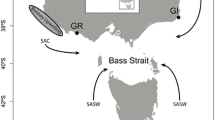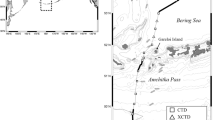Abstract
A novel classification system was applied to the sea level anomaly (SLA) environment around Marion Island. We classified the SLA seascape into habitat types and calculated percentage of habitat use of ten juvenile southern elephant seals (SES). Movements were compared to SLA and SLA slope values indicative of ocean eddy features. This classification provides a measure of habitat change due to seasonal fluctuations in SLA. Some of the seals made two migrations in different seasons, each of similar duration and proportions of potential foraging behaviour. The seals in this study did not use any intense eddy features, but their behaviours varied with SLA class. Potential foraging behaviour was positively influenced by negative SLA values (i.e. areas of below average sea surface height). Searching behaviour during the winter was more likely at eddy edges where high SLA slope values correlated with low SLA values. Though the seals did not forage within newly spawned eddies, they did forage near the sub-Antarctic front. Plankton and other biological resources transported by eddies formed at the subtropical convergence zone are evidently concentrated in this region and enhance the food chain there, forming a foraging ground for juvenile SES from Marion Island.






Similar content being viewed by others
References
Ansorge IJ, Lutjeharms JRE (2003) Eddies originating at the south-west Indian Ridge. J Mar Syst 39:1–18
Ansorge IJ, Lutjeharms JRE (2005) Direct observations of eddy turbulence at a ridge in the Southern Ocean. Geophys Res Lett. doi:10.1029/2005GL022588
Ansorge IJ, Froneman PW, Pakhomov EA, Lutjeharms JRE, Perissonotto R, van Ballegooyen RC (1999) Physical–biological coupling in the waters surrounding the Prince Edward Islands (Southern Ocean). Polar Biol 21:135–145
Backeberg BC, Penven P, Rouault M (2012) Impact of intensified Indian Ocean winds on mesoscale variability in the Agulhas system. Nat Clim Change 2:608–612
Bailleul F, Cotté C, Guinet C (2010) Mesoscale eddies as foraging areas of a deep diving predator, the southern elephant seal. Mar Ecol Prog Ser 408:251–264
Bakun A (1996) Fronts and eddies as key structures in the habitat of marine fish larvae: opportunity, adaptive response and competitive advantage. Scientia Marina 70(S2):105–122
Bates DM (2010) lme4: mixed-effects modeling with R. http://lme4.r-forge.Rproject.org/book
Bernard ATF, Ansorge IJ, Froneman PW, Lutjeharms JRE, Bernard KS, Swart NC (2007) Entrainment of Antarctic euphausiids across the Antarctic Polar Front by a cold eddy. Deep Sea Res Part 1: Oceanogr Res Pap 54(10):1840–1851
Bestley S, Patterson TA, Hindell MA, Gunn JS (2010) Predicting feeding success in a migratory predator: integrating telemetry, environment, and modeling techniques. Ecology 91:2373–2384
Bestley S, Jonsen ID, Hindell MA, Guinet C, Charrassin JB (2013) Integrative modelling of animal movement: incorporating in situ habitat and behavioural information for a migratory marine predator. P Roy Soc B Biol Sci 280:20122313
Bester MN (1988) Chemical restraint of Antarctic fur seals and southern elephant seals. S Afr J Wildl Res 18:57–60
Biuw M, Boehme L, Guinet C, Hindell M, Costa D, Charrassin JB, Roquet F, Bailleul F, Meredith M, Thorpe S, Tremblay Y, McDonald B, Park YH, Rintoul SR, Bindhoff N, Goebel M, Crocker D, Lovell P, Nicholson J, Monks F, Fedak MA (2007) Variations in behaviour and condition of a southern ocean top predator in relation to in situ oceanographic conditions. P Natl Acad Sci Biol 104:13705–13710
Bost CA, Cotté C, Bailleul F, Cherel Y, Charrassin JB, Guinet C, Ainley DG, Weimerskirch H (2009) The importance of oceanographic fronts to marine birds and mammals of the southern oceans. J Mar Syst 8:363–376
Brandt SB (1983) Temporal and spatial patterns of lanternfish (family Myctophidae) communities associated with a warm-core eddy. Mar Biol 74:231–244
Breed GA, Jonsen ID, Myers RA, Bowen WD, Leonard ML (2009) Sex-specific, seasonal foraging tactics of adult grey seals (Halichoerus grypus) revealed by state-space analysis. Ecology 90:3209–3221
Campagna C, Piola AR, Marin MR, Lewis M, Fernández T (2006) Southern elephant seal trajectories, fronts and eddies in the Brazil/Malvinas confluence. Deep Sea Res Part 1: Oceanogr Res Pap 53:1907–1924
Campagna C, Piola AR, Marin MR, Lewis M, Zajaczkovski U, Fernández T (2007) Deep divers in shallow seas: southern elephant seals on the Patagonian shelf. Deep Sea Res Part 1: Oceanogr Res Pap 55:1792–1814
Connor DW, Allen JH, Golding N, Lieberknecht LM, Northen KO, Reker JB (2003) The national marine habitat classification for Britain and Ireland. Version 0.3.02. Introductory Text. Joint Nature Conservation Committee, Peterborough. www.jncc.gov.uk/marinehabitatclassification. 20 April 2015
Costello MJ (2009) Distinguishing marine habitat classification concepts for ecological data management. Mar Ecol Prog Ser 397:253–268
Cotté C, Park YH, Guinet C, Bost CA (2007) Movements of foraging king penguins through marine mesoscale eddies. Proc R Soc B 274:2385–2391
de Bruyn PJN, Tosh CA, Oosthuizen WC, Phalanndwa MV, Bester MN (2008) Temporary marking of unweaned southern elephant seal (Mirounga leonina L.) pups. S Afr J Wildl Res 38:133–137
de Bruyn PJN, Tosh CA, Oosthuizen WC, Bester MN, Arnould JPY (2009) Bathymetry and frontal system interactions influence seasonal foraging movements of lactating subantarctic fur seals from Marion Island. Mar Ecol Prog Ser 394:263–276
Dragon AC, Monestiez P, Bar-Hen A, Guinet C (2010) Linking foraging behaviour to physical oceanographic structures: southern elephant seals and mesoscale eddies east of Kerguelen Islands. Prog Oceanogr 87:61–71
Durgadoo JV, Ansorge IJ, Lutjeharms JRE (2010) Oceanographic observations of eddies impacting the Prince Edward Islands, South Africa. Antarct Sci 22:211–219
Erickson AW, Bester MN (1993) Immobilization and capture. In: Laws RM (ed) Antarctic seals: research methods and techniques. Cambridge University Press, Cambridge, pp 46–89
ESRI (2011) ArcGIS desktop: release 10. Environmental Systems Research Institute, Redlands
Field I, Harcourt R, de Bruyn PJN, Boehme L, Charrassin JB, McMahon CR, Bester MN, Fedak M, Hindell MA (2012) Refining instrument attachment on phocid seals. Mar Mamm Sci 28:E325–E332
Froneman PW, Perissinotto R (1996) Structure and grazing of the microzooplankton communities of the subtropical convergence and a warm-core eddy in the Atlantic sector of the Southern Ocean. Mar Ecol Prog Ser 135:237–245
Gregr E, Bodtker K (2007) Adaptive classification of marine ecosystems: identifying biologically meaningful regions in the marine environment. Deep Sea Res Part 1: Oceanogr Res Pap 54:385–402
Gregr EJ, Ahrens AL, Perry RI (2012) Reconciling classifications of ecologically and biologically significant areas in the world’s oceans. Mar Policy 36:716–726
Hardman-Mountford NJ, Hirata T, Richardson KA, Aiken J (2008) An objective methodology for the classification of ecological pattern into biomes and provinces for the pelagic ocean. Remote Sens Environ 112:3341–3352
Hofmeyr GJG, Kirkman SP, Pistorius PA, Bester MN (2012) Natal site fidelity by breeding female southern elephant seals in relation to their history of participation in the winter haulout. Afr J Mar Sci 34:373–382
Jenness J (2010) DEM Surface Tools v. 2.1. 254
Jonker FC, Bester MN (1998) Seasonal movements and foraging areas of adult southern female elephant seals, Mirounga leonina, from Marion Island. Antarct Sci 10:21–30
Jonsen ID, Mills Flemming J, Myers RA (2005) Robust statespace modelling of animal movement data. Ecology 86:2874–2880
Kirkman SP, Bester MN, Pistorius PA, Hofmeyr GJG, Owen R, Mecenero S (2001) Participation in the winter haul-out by southern elephant seals (Mirounga leonina). Antarct Sci 13:380–384
Klages NTW, Bester MN (1998) Fish prey of fur seals Arctocephalus spp. at subantarctic Marion Island. Mar Biol 131:559–566
Lutjeharms JRE, Gordon AL (1987) Shedding of an Agulhas ring observed at sea. Nature 325:138–140
Lutjeharms JRE, Valentine HR (1988) Eddies at the subtropical convergence south of Africa. J Phys Oceanogr 18:761–774
Massie PP, McIntyre T, Ryan PG, Bester MN, Bornemann H, Ansorge IJ (2015) The role of eddies in the diving behaviour of female southern elephant seals. Polar Biol. doi:10.1007/s00300-015-1782-0
McIntyre T, Bornemann H, Plӧtz J, Tosh CA, Bester MN (2011) Water column use and forage strategies of female southern elephant seals from Marion Island. Mar Biol 158:2125–2139
Meredith MP, Hogg AM (2006) Circumpolar response of Southern Ocean eddy activity to a change in the Southern Annular Mode. Geophys Res Lett. doi:10.1029/2006GL026499
Nel DC, Lutjeharms JRE, Pakhomov EA, Ansorge IJ, Ryan PG, Klages NTW (2001) Exploitation of mesoscale oceanographic features by grey headed albatross Thalassarche chrysostoma in the southern Indian Ocean. Mar Ecol Prog Ser 217:15–26
Oosthuizen WC, Bester MN, Tosh CA, Guinet C, Besson D, de Bruyn PJN (2011) Dispersal and dispersion of southern elephant seals in the Kerguelen province, Southern Ocean. Antarct Sci 23:567–577
Pakhomov EA, Froneman PW (2000) Composition and spatial variability of macroplankton and micronekton within the Antarctic Polar Frontal Zone of the Indian Ocean during austral autumn 1997. Polar Biol 23:410–419
Pakhomov EA, Perissinotto R (1997) Mesozooplankton community structure and grazing impact in the region of the subtropical convergence south of Africa. J Plankton Res 19:675–691
Pakhomov EA, Perissinotto R, McQuaid CD (1994) Comparative structure of the macro-zooplankton/mikronekton communities of the Subtropical and Antarctic Polar Fronts. Mar Ecol Prog Ser 111:155–169
Pakhomov EA, Ansorge IJ, Kaehler S, Vumazonke LU, Gulekana K, Bushula T, Balt C, Paul D, Hargey N, Stewart H, Chang N, Furno L, Mkatshwa S, Visser C, Lutjeharms JRE, Hayes-Foley P (2003) Studying the impact of ocean eddies on the ecosystem of the Prince Edward Islands: DEIMEC II. S Afr J Sci 99:187–190
Pascual A, Faugère Y, Larnicol G, Le Traon PY (2006) Improved description of the ocean mesoscale variability by combining four satellite altimeters. Geophys Res Lett 33(2):L02611
Pistorius PA, Kirkman SP, Bester MN, Taylor FE (2002) Implications of the winter haulout for future survival and resighting probability of southern elephant seals at Marion Island. S Afr J Wildl Res 32:59–63
Polovina J, Uchida I, Balazs G, Howell EA, Parker D, Dutton P (2006) The Kuroshio Extension Bifurcation Region: a pelagic hotspot for juvenile loggerhead sea turtles. Deep Sea Res II. 53:326–339
Reisinger RR, de Bruyn PJN, Tosh CA, Oosthuizen WC, Mufanadzo NT, Bester MN (2011) Prey and seasonal abundance of killer whales at sub-Antarctic Marion Island. Afr J Mar Sci 33:99–105
Roberts JJ, Best BD, Dunn DC, Treml EA, Halpin PN (2010) Marine Geospatial Ecology Tools: an integrated framework for ecological geoprocessing with ArcGIS, Python, R, MATLAB, and C++. Environ Model Softw 25:1197–1207
Schick RS, New LF, Thomas L, Costa DP, Hindell MA, McMahon CR, Robinson PW, Simmons SE, Thums M, Harwood J, Clark JS (2013) Estimating resource acquisition and at-sea body condition of a marine predator. J Anim Ecol. doi:10.1111/1365-2656.12102
Steele JH (1989) The ocean ‘landscape’. Landsc Ecol 3:185–192
Tosh CA, Bornemann H, Ramdohr S, Schröder M, Martin T, Carlini A, Plötz J, Bester MN (2009) Adult male southern elephant seals from King George Island utilize the Weddell Sea. Antarct Sci 21:113–121
Tosh CA, Steyn J, Bornemann H, van den Hoff J, Stewart BS, Plӧtz J, Bester MN (2012) Marine habitats of juvenile southern elephant seals from Marion Island. Aquat Biol 17:71–79
Townsend CR, Hildrew AG (1994) Species traits in relation to a habitat template for river systems. Freshw Biol 31:265–275
Ward TJ, Vanderklift MA, Nicholls AO, Kenchington RA (1999) Selecting marine reserves using habitats and species assemblages as surrogates for biological diversity. Ecol Appl 9:691–698
Zevenbergen LW, Thorne CR (1987) Quantitative analysis of land surface topography. Earth Surf Processes Landf 12:47–56
Acknowledgments
The Alfred Wegener Institute for Polar and Marine Research (Germany), the Department of Science and Technology through the National Research Foundation (South Africa), the Department of Environmental Affairs via the South African National Antarctic Programme, the Australian Antarctic Division and Hubbs-SeaWorld Research Institute provided financial, material and logistical support.
Author information
Authors and Affiliations
Corresponding author
Additional information
Responsible Editor: G. Pierce.
Reviewed by V. Valavanis and undisclosed experts.
Rights and permissions
About this article
Cite this article
Tosh, C.A., de Bruyn, P.J.N., Steyn, J. et al. The importance of seasonal sea surface height anomalies for foraging juvenile southern elephant seals. Mar Biol 162, 2131–2140 (2015). https://doi.org/10.1007/s00227-015-2743-4
Received:
Accepted:
Published:
Issue Date:
DOI: https://doi.org/10.1007/s00227-015-2743-4




